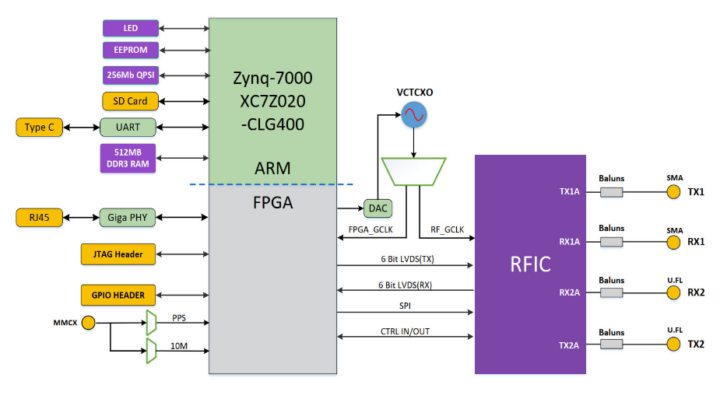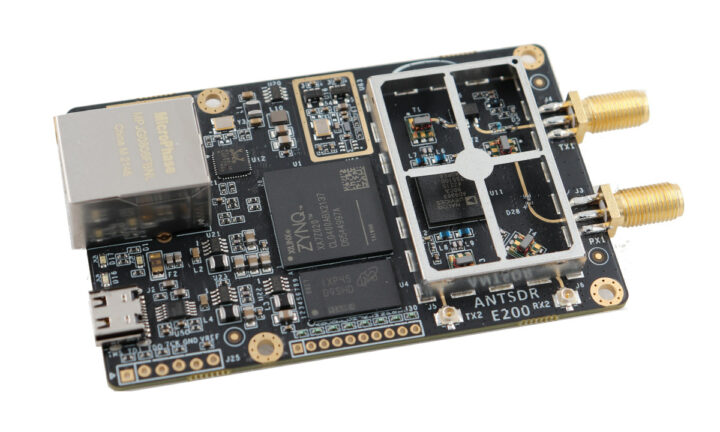We’ve just written about the uSDR M.2 SDR module on Crowd Supply, but it turns out the crowdfunding platform is hosting another SDR (Software-Defined Radio) project with the AntSDR E200 board equipped with an AMD Embedded Zynq 7020 SoC FPGA and an Analog Devices AD9363 or AD9361 RF chipset, and providing Gigabit Ethernet connectivity to the host.
The board can operate in the 70 MHz – 6 GHz range with the AD9361 chipset, and the 325 MHz – 3.8 GHz range with the AD9363, supports 2×2 MIMO with two SMA antenna connectors and two U.FL connectors, and also features expansion interfaces for GPIOs.
AntSDR E200 specifications:
- SoC FPGA – AMD Embedded/Xilinx Zynq 7020 dual-core Arm Cortex-A9 processor and FPGA with 85K logic cells, 4.9Mb Block RAM, 220 DSP slices
- System Memory – 512MB DDR3
- Storage – 256 Mbit QSPI flash for firmware; microSD card slot (bottom side)
- RF
- Chipset – Analog Devices AD9363 or AD9361
- Channels – 2 × 2 MIMO
- Sample Rate: 200 KHz – 61.44 MHz
- Tuning Range – AD9363: 325 MHz – 3.8 GHz, AD9361: 70 MHz – 6 GHz
- RF bandwidth – AD9363: 200 KHz – 20 MHz, AD9361: 200 KHz – 56 MHz
- RF Transmit Power – Up to 10 dBm
- Antenna connectors – 2 SMA and 2 U.FL connectors
- Networking – Gigabit Ethernet RJ45 port
- USB – USB Type-C port for serial access and power
- Expansion – 8x PL GPIO interfaces
- Clock System – 40M VCXO and PPS/10M Reference clock input
- Debugging – FPGA JTAG connector for external JTAG programmer/debugger

On the software side, the AntSDR E200 board relies on Analog Devices’ LibIIO library for interfacing with Linux IIO (Industrial Input/Output) devices and the USRP Hardware Driver (UHD) is an open-source, cross-platform driver which MicroPhase Technology – the company being the AntSDR E200 – ported to the SDR board. They’ve also written two different firmware, the first one to make the board compatible with the ADALM-PLUTO evaluation kit and the other with basic UHD components, enabling AntSDR to communicate with the host. You’ll find the source code and PDF schematics on GitHub, as well as online documentation on Read the Docs.
So what exactly can you do with the AnSDR E200 board? Potential applications include Ham radio, air traffic monitoring, public safety such as monitoring police and emergency services communications, remote sensing (e.g. detect and analyze signals from weather radar systems), satellite communications, and radio astronomy. It’s also possible to experiment with WiFi using the OpenWiFi open-source project, or create your own GSM/LTE cellular base station with OsmoBTS GSM base station implementation or rsRAN_4G open-source SDR 4G software suite from (SRS).
The AntSDR E200 board has already surpassed its $20,000 funding goal on Crowd Supply with close to $100,000 raised so far. Rewards start at $299 for the AD9363 model and $499 for the AD9361 without antennas, the case, and other accessories which can be added as options. Shipping adds $8 to the US, and $18 to the rest of the world, and rewards are expected to start shipping before the end of September, except for the case which will only be available by the end of October.

Jean-Luc started CNX Software in 2010 as a part-time endeavor, before quitting his job as a software engineering manager, and starting to write daily news, and reviews full time later in 2011.
Support CNX Software! Donate via cryptocurrencies, become a Patron on Patreon, or purchase goods on Amazon or Aliexpress. We also use affiliate links in articles to earn commissions if you make a purchase after clicking on those links.






This covers an impressively large spectrum! Even the rx bandwidth seems to be quickly limited by the GigE. At 56 Msps you’re limited to 16 bits per sample at GigE speeds, that doesn’t leave much margin for for the protocol etc!
The AD9361 is 12-bit and I plus Q channel are required for processing SDR data on a host computer. A dedicated back to back gigabit Ethernet connection fully saturated allowing for all the packet overheads would be able to transfer in theory ~94.93%*** of that (closer to 111.9 MiB/second in the real world). So in reality you are talking about a maximum sample rate of ~39,111,884 samples per second that can be transferred off the board (~39MHz of bandwidth for 1 channel, half that for 2, and since Gigabit is full duplex less that half, due to ACK packets, if using 2×2 MIMO). But lucky the real advantage of a large FPGA is that most of the processing can happen on the board, and the processed data transferred off board using a lower data rate.
If you wanted 16-bit samples you could decimate that 56MHz of bandwidth down to 218.75kHz (56/(4^4)), to gain extra dynamic range through processing.
*** ref: https://networkengineering.stackexchange.com/questions/19976/trying-to-find-out-exact-tcp-overhead-cost
The real problem with any new SDR is that the biggest part of SDR is the Software and it may take a number of years for that to mature. Having the finest hardware in the world, without great Software to access all the features is problematic.
I am an AntSDR backer (the 6GHz version… if its half as good as an Ettus B200 series device it will be a bargain), so obviously I’m biased towards believing that the device will perform as advertised… take the following with a grain of salt:
The dual API method they’ve chosen may help ease software compatibility. I don’t know anything about libiio, but there doesn’t seem to be any shortage of SDR tools that use the UHD interface. Out of the box it should be usable with many tools (I’ll be happy with GQRX, GnuRadio, and a few simple tools I’ve written myself using the UHD library).
For tools that actually use the FPGA, you are right. It may take a while or may never happen. Perhaps developers may be able to use designs created for the Ettus B2xx series as a starting point?
I’m not sure that TCP overhead would be applicable. I have only used UHD-based devices over USB, so I actually don’t know what UHD network traffic looks like. Since Ettus uses UHD for very high end devices with 1 and 10Gb Ethernet ports, I suspect it supports low-latency/low-overhead packet formatting. Worst case would be standard UDP which has less overhead than TCP. The andsdr does not support 10/100 modes, so I suspect (ok, hope) it should also support fun stuff like Jumbo Frames to help minimize the per-packet overhead. Its not like the traffic has to be routable.
I’m not an experienced SDR developer. I’ve had the good fortune to get access to a couple of Ettus B200 series devices and have made minimal use of their capabilities… mainly for wide-band spectrum monitoring and a few simple test signal generator/measurement tools. It’s enough to make me a believer in the AD936x chips and to want to own one of my own. If the AntSDR RF front-ends are any good and they deliver on a good UHD-based interface, I should be happy.
… or I’ve blown $500. That would really suck, but I’ve done worse.
Potential applications may include some Ham radio, but there’s a plethora of Ham bands below the 70MHz cutoff of the AD9361. Is that a case of misleading advertising?
How so? “It doesn’t do everything!” doesn’t mean the same as “It doesn’t do anything.” There are plenty of bands over 70MHz.
The Ubiquiti LTU Lite is based on an Altera Cyclone FPGA and an AD9361 (relabelled as AirFiber). The unit is essentially a complete MIMO 5GHz SDR with Gigabit Ethernet for $100. Might be worth reverse engineering. Also hardware mods are necessary for it to operate outside of the 5GHz band.
Internal Photos here
https://fccid.io/SWX-LTUL/Internal-Photos/Internal-Photos-4380816
The component layout around the AD9361 matches the ballout in the datasheet. And the reverse side of the PCB where the vias are, underneath the AD9361 matches the pins that carry the I/Q sampled data.
Interesting…but I think the layout and package of the AD9361 is shared by the lower tiered parts in that series, the AD9362 and AD9363. I would expect this relatively low cost product is not the 61 but a lesser version.similar the Pluto which used one of those parts and was initially introduced at a $99 price point.